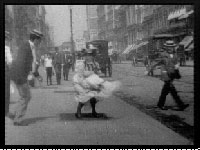1744 The first written record of ice cream in America (and the first use of the exact phrase "ice cream" rather than "iced cream" is made when a journal entry by William Black of Virginia notes that Maryland Colonial Governor Thomas Bladen notes servedice cream ("After which came a Dessert no less Curious; Among the Rarities of which it was Compos'd, was some fine Ice Cream which, with the Strawberries and Milk, eat most Deliciously…") to him and other dinner guests at the Governor's home in Annapolis:
not contested.
1774 Immigrant from London Philip Lenzi, a caterer, opens the nation's first ice cream parlor, on Dock Street in New York City. On May 12, 1777, Lenzi places the first advertisement for ice cream in America in The New York Gazette and Weekly Mercury, noting that he would make it available "almost every day.":
not contested.
1780s George and Martha Washington often serve ice cream to their guests. In one year alone, President Washington spends over $200 on ice cream, a huge amount at the time:
not contested.
1784 Thomas Jefferson records a French recipe for vanilla ice cream (custard based) in his recipe book. In 1802 at a White House state dinner, he serves small balls of vanilla ice cream encased in warm pastry:
not contested.
1806 Frederic Tudor begins cutting and shipping ice from Fresh Pond in Cambridge, Massachusetts, to states south and around the world:
not contested.
1813 James and Dolley Madison serve strawberry ice cream at Madison's second inaugural ball. Mrs. Jeremiah ("Aunt Sallie") Shadd, a freed black slave, who has a catering business in Wilmington, Delaware, makes the ice cream from her own recipe. Also working at the White House as a chef is African-American cook and entrepreneur Augustus Jackson, who, after he leaves the White House and moves to Philadelphia, creates many new ice cream recipes and a sophisticated system of distributing it to retail merchants in large tin cans:
not contested.
1832 Massachusetts brass founder John Matthews invents the soda fountain:
contested. Some sources credit Pennsylvania physician Samuel Fahnstock with inventing it in 1819. And some credit Jacob Ebert of Cadiz, Ohio and George Dulty of Wheeling, Virginia with inventing it in 1833, and taking out a patent on it.
1843 Philadelphia housewife Nancy M. Johnson invents the hand-crank ice cream freezer, and receives a patent for it, the rights to which she sells for $200 to wholesaler William G. Young:
not contested.
1851 Quaker Jacob Fussell, using icehouses and a large version of Johnson's ice cream freezing machine, begins to produce ice cream from his Baltimore, Maryland factory (and then in Washington, DC, Boston, and New York), and selling it on the street from carts, helping to turn ice cream into a cheap, regular treat:
not contested.
1867 J. B. Sutherland of Detroit, Michigan patents the refrigerated railroad car:
not contested.
1874 The ice cream soda is created by soda concessionaire Robert M. Green for the semicentennial celebration of the Franklin Institute in Philadelphia. He had been making soda drinks of sweet cream, syrup, ice, and carbonated water, a drink already well-known and called, fancifully, "ice cream soda." When he runs out of cream, he substitutes ice cream (Philadelphia-style vanilla ice cream, which means it was not custard based):
contested. Some sources say the ice cream soda was invented by two newsboys, John Robertson and Francis Tietz, at Kline's Confectionary Store in New York City in 1872, when they asked Mr. Kline to put a scoop of vanilla ice cream and a slice of pineapple into a glass of soda water.
1878 William Clewell, a confectioner in Reading, Pennsylvania, receives the first patent for an ice cream scoop. It is shaped like a candle snuffer:
not contested.
1881 The ice cream sundae is created, in Two Rivers, Wisconsin, by Ed C. Berners, who operates an ice cream shop at 1404 Fifteenth Street. A teen-aged customer, George Hallauer, asks Mr. Berner to put some chocolate sauce on his ice cream. Prior to this, chocolate sauce had been used only in ice cream sodas. Berners complies and charges Hallauer—and other customers afterwards—5 cents. He serves it only on Sunday:
contested. Some sources say the ice cream sundae was invented on Sunday afternoon, April 3, 1892, by Chester C. Platt, proprietor of the Platt & Colt Pharmacy in Ithaca, New York, when he improvised a bowl of vanilla ice cream, topped with cherry syrup and candied cherry, calling it a "Cherry Sunday," in honor of the day in which it is invented. Other sources say the phrase "ice cream sundae" was created in Evanston, Illinois, sometime in the late 1800s, when, in an effort to circumvent the religious ban against frivolously "sucking soda" on Sundays, Garwoods' Drugstore offered its customers what was essentially a concoction of everything in an ice cream soda, without the soda.
1894 Edson Clemant Baugham patents a spring-handle, one-handed ice cream scoop, which is manufactured by the Kingery Company of Cincinnati:
not contested.
1897 African-American inventor Alfred L. Cralle, while working in Pittsburgh, Pennsylvania, patents the lever-operated, half-globed-shaped, hand ice cream scooper:
not contested.
1902 Mechanical refrigeration takes over from ice and salts in the ice cream industry:
not contested.
1904 The ice cream cone is introduced, at the St. Louis World's Fair, Louisiana Purchase Exposition. An ice cream vendor named Arnold Fornachou runs out of dishes and a Syrian vendor named Abe Doumar (or a Lebanese vendor named Ernest A. Hamwi) seizes the moment to roll a "zalabia"—a sugar waffle—into a cone and comes to his rescue:
contested. Some sources say the ice cream cone was invented by Italian immigrant Italo Marciony of New York,  a pushcart ice cream vendor in New York, in 1896, who also, perhaps, invented the ice cream sandwich by putting a slice of ice cream between waffle squares cut from a sheet. Other sources say the ice cream cone has its origins in the mists of history, but was first described in Mrs. Marshall's Cookery Book, whose author, Agnes Marshall, published it in London in 1888. Still others discern a woman licking an ice cream cone in an 1807 picturing fashionable customers eating at the Frascati café in Paris, although this is uncertain because cone-shaped ice cream bowls were not unknown at the time.
a pushcart ice cream vendor in New York, in 1896, who also, perhaps, invented the ice cream sandwich by putting a slice of ice cream between waffle squares cut from a sheet. Other sources say the ice cream cone has its origins in the mists of history, but was first described in Mrs. Marshall's Cookery Book, whose author, Agnes Marshall, published it in London in 1888. Still others discern a woman licking an ice cream cone in an 1807 picturing fashionable customers eating at the Frascati café in Paris, although this is uncertain because cone-shaped ice cream bowls were not unknown at the time.
1904 Soda jerk (and soon-to-be graduate of University of Pittsburgh's School of Pharmacy) David E. Strickler invents the banana split (and the elongated dish to serve it in) while working in a drug store in Latrobe, Pennsylvania:
contested. Some sources credit Ernest Hazard, owner of Hazard's Restaurant in Wilmington, Ohio, with inventing the banana split in 1907, and his cousin, Clifton Hazard, with inventing the name "banana split."
1905 Eleven-year-old Frank Epperson leaves his fruit-flavored drink (powdered flavor plus water) outside in cold weather, with a stirring stick in it, and "invents" the "Epsicle ice pop," which he patents eighteen years later, in 1924. His children rename it the "Popsicle.":
not contested.
1906 In C. C. (Clarence Clifton) Brown's Ice Cream Parlour at 7007 Hollywood Boulevard in Los Angeles, California, the first hot fudge sundae is served:
not contested.
1910 President William Howard Taft begins keeping a Holstein cow named "Pauline Wayne" on the White House lawn, replacing one named "Mooley Wooly," who had provided milk (and from it, ice cream) for the First Family for a year and a half:
not contested.

1911 General Electric offers an electric refrigerator for home use:
not contested.
1919 Prohibition becomes law, causing some beer manufacturers to become ice cream manufacturers and some saloons to become ice cream parlors:
not contested.
1919 Onawa, Iowa inventor and high school teacher Christian Nelson, who moonlights as a soda jerk, invents the first chocolate-covered ice cream bar He calls it the "Temptation I-Scream Bar," and writes the advertising jingle, "I scream, you scream, we all scream for the I-Scream Bar." After going into partnership with confectioner Russell Stover, Nelson changes its name and patents it as the "Eskimo Pie.":
not contested.
1920 Youngstown, Ohio candy maker Harry Burt invents the first ice cream on a stick, the Good Humor Bar:
not contested.
1921 The Commissioner of Ellis Island provides that a scoop of vanilla ice cream be included in a "Welcome to America" meal for immigrants arriving through the facility:
not contested.
1922 Chicago Walgreens employee Ivar "Pop" Coulson takes a malted milk drink (milk, chocolate syrup, and malt), adds two scoops of vanilla ice cream, mixes it up, and creates the milk shake:
not contested.
1923 H. P. Hood of Boston introduces the paper cup filled at the factory with ice cream at the National Ice Cream Convention in Cleveland. He calls it the "Hoodsie," but it is renamed the "Dixie Cup" in 1924:
not contested.
1923 A & P supermarkets introduce ice cream cabinets in their 1,200 stores nationwide:
not contested.
1926 The Hershey's Company expands its product offerings to include Hershey's Syrup:
not contested.
1931 Ernest Wiegand, horticulturalist at Oregon Agricultural College (now Oregon State University) in Corvallis, develops the modern method of firming and preserving maraschino cherries:
not contested.
1940 J. F. "Grandpa" and H. A. "Alex" McCullough, proprietors of the Homemade Ice Cream Company in Green River, Illinois, begin to market "soft serve" ice cream under the name of "Dairy Queen.":
not contested.
1984 President Ronald Reagan designates July as National Ice Cream Month and the third Sunday of the month as National Ice Cream Day:
not contested.
 The tobacco plant, however, is quite temperamental and demanding. Even within a single field, the plant would be influenced by the amount of sunlight, minerals, water, and wind. Not all of the field would yield the best tobacco, even in years where there was neither too little rain nor too much. Also, growing tobacco rapidly exhausted the soil's nutrients. Without the addition of fertilizer, three years of growing tobacco was all it took to deplete the soil. The easiest solution was to have available large areas of cheap land so that the grower could shift his fields onto virgin soil when his original plot could no longer sustain his crop. At least in the first decades of the colonial settlements in the area, large tracts of cheap land were precisely what the colonists had, so this, too, made it "easy" for them to cultivate tobacco.
The tobacco plant, however, is quite temperamental and demanding. Even within a single field, the plant would be influenced by the amount of sunlight, minerals, water, and wind. Not all of the field would yield the best tobacco, even in years where there was neither too little rain nor too much. Also, growing tobacco rapidly exhausted the soil's nutrients. Without the addition of fertilizer, three years of growing tobacco was all it took to deplete the soil. The easiest solution was to have available large areas of cheap land so that the grower could shift his fields onto virgin soil when his original plot could no longer sustain his crop. At least in the first decades of the colonial settlements in the area, large tracts of cheap land were precisely what the colonists had, so this, too, made it "easy" for them to cultivate tobacco.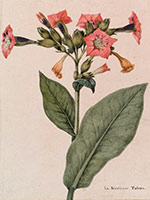
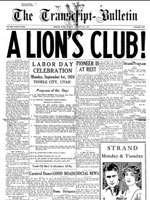
 On June 15, 1904, the General Slocum departed on the annual Sunday School excursion of St. Mark's German Lutheran Church. However, unbeknownst to passengers and crew, a fire had broken out in a storage room. Many passengers died of burns, and others drowned, unable to swim. The steamer's defective life preservers added to the death toll. The preservers' insides, made of finely-ground cork, quickly became waterlogged when the preservers' rotten covers fell away. One survivor told of a woman with three children. The mother and two girls could swim, but one daughter could not. The daughter was put in a life preserver and tossed overboard, where she immediately sank.
On June 15, 1904, the General Slocum departed on the annual Sunday School excursion of St. Mark's German Lutheran Church. However, unbeknownst to passengers and crew, a fire had broken out in a storage room. Many passengers died of burns, and others drowned, unable to swim. The steamer's defective life preservers added to the death toll. The preservers' insides, made of finely-ground cork, quickly became waterlogged when the preservers' rotten covers fell away. One survivor told of a woman with three children. The mother and two girls could swim, but one daughter could not. The daughter was put in a life preserver and tossed overboard, where she immediately sank. If you are curious about the Mary Celeste, one interesting online resource is "
If you are curious about the Mary Celeste, one interesting online resource is "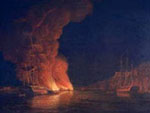
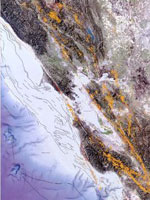
 a pushcart ice cream vendor in New York, in 1896, who also, perhaps, invented the ice cream sandwich by putting a slice of ice cream between waffle squares cut from a sheet. Other sources say the ice cream cone has its origins in the mists of history, but was first described in Mrs. Marshall's Cookery Book, whose author, Agnes Marshall, published it in London in 1888. Still others discern a woman licking an ice cream cone in an 1807 picturing fashionable customers eating at the Frascati café in Paris, although this is uncertain because cone-shaped ice cream bowls were not unknown at the time.
a pushcart ice cream vendor in New York, in 1896, who also, perhaps, invented the ice cream sandwich by putting a slice of ice cream between waffle squares cut from a sheet. Other sources say the ice cream cone has its origins in the mists of history, but was first described in Mrs. Marshall's Cookery Book, whose author, Agnes Marshall, published it in London in 1888. Still others discern a woman licking an ice cream cone in an 1807 picturing fashionable customers eating at the Frascati café in Paris, although this is uncertain because cone-shaped ice cream bowls were not unknown at the time.
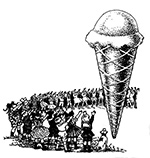
 Teenagers today play a central role in American culture and society. They exist not only as high school students, but as closely watched consumers and trendsetters. Yet in 1900, teenagers did not exist. There were young people in their teens, but there was no distinct teenage culture.
Teenagers today play a central role in American culture and society. They exist not only as high school students, but as closely watched consumers and trendsetters. Yet in 1900, teenagers did not exist. There were young people in their teens, but there was no distinct teenage culture.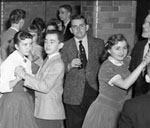

 If you're in Louisiana, the
If you're in Louisiana, the 
